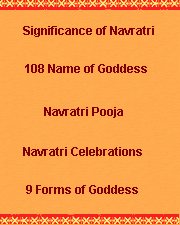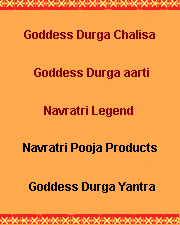|





| |
Navratri, Navratra,
Goddess, Lord, Goddess Durga , Maa, Maa Durga, Nav Durga, form, nine forms
Navratri>Nine
forms
|
Navratri -
Navdurga - nine forms of Maa Durga |
Chaitra Navaratra 2020
(March 25th to April 2nd)
  
Navratri Pooja
- Navdurga Puja
-
The festival of Navratri begins.
1st - 3rd day of Navratri
On the first day of the Navaratra pooja, 'Kalash Shthaapna. is done in the
puja room. These initial days of puja are dedicated to Durga Maa, the Goddess of
power and energy. Her various manifestations, Kumari, Parvati and Kali
are all worshipped during these days. They represent the three different
classes of womanhood that include the child, the young girl and the
mature woman.
-
Lalita Panchami
4th - 6th day of Navratri During these days of Navratri puja, Lakshmi Maa, the
Goddess of peace and prosperity is worshipped. On the fifth day which is
known as Lalita Panchami, it is traditional, to gather and display all
literature available in the house, light a lamp or 'diya' to invoke
Saraswati Maa, the Goddess of knowledge and art.
-
Durga Ashtami Puja
These final days of Navratri pooja belongs to Saraswati Maa who is worshipped to acquire
the spiritual knowledge. This in turn will free us from all earthly
bondage. But on the 8th day of this colorful festival, yajna (holy fire)
is performed. Ghee (clarified butter), kheer (rice pudding) and sesame
seeds form the holy offering to Goddess Durga Maa.
-
Mahanavami Puja. Navratri ends with the final pooja of Navratri
on the ninth day. The festival of Navratri culminates in Mahanavami. On this day Kanya
Puja is performed. Nine young girls representing the nine forms of
Goddess Durga are worshiped. Their feets are washed as a mark of respect
for the Goddess and then they are offered food mainly consisting kala
chana, halwa and poori. Then after new clothes or gifts by the
worshiper. This ritual is performed in most parts of the country.
Kalash Sthaapna in Navraatri Pooja
 On
the first day of the Navaratras, a small bed of mud is prepared in the puja room
of the house and barley seeds are sown on it. On this Bed a Kalash made of
Copper is kept and filled with water. Above the pot a bowl filled with rice is
kept. A dry Cococunt wrapped with mango leaves is then kept over this kalash.
This Kalash is believed to be a symbolic form of Goddess Durga. By keeping kalash one
invocates the goddess in the Kalash. On
the first day of the Navaratras, a small bed of mud is prepared in the puja room
of the house and barley seeds are sown on it. On this Bed a Kalash made of
Copper is kept and filled with water. Above the pot a bowl filled with rice is
kept. A dry Cococunt wrapped with mango leaves is then kept over this kalash.
This Kalash is believed to be a symbolic form of Goddess Durga. By keeping kalash one
invocates the goddess in the Kalash.
On the tenth day, the shoots are about 3 - 5
inches in length. After the puja, these seedlings are pulled out and given to
devotees as a blessing from god. This Kalash must not be touched during the nine
days . One diya is lit close to this Kalash which is supposed to burn
endlessly for nine days. This is known as Akhand Jyoti.
Many people believe that the length of the Shoots
determines the Quantum of income that they will have in coming six months. This
belief could have been because India was basically an agrarian economy wherein
the productivity of the Land determined one's income.
In Navratra each night( ratri) is dedicated
to one form of Goddess Durga.
|

Maa Shailputri

On the first day of Navratri we worship Goddess Shailputri. Shailputri
means the Daughter of a Mountain. As she took birth as the daughter
of Parvatraaj Himalaya (King of the Mountain Himalaya) she is known
as Shailputri.
Mounting a
bullock the mother has a lance in her right hand and the lotus
flower in the left. She is the first one among the nine aspects of
Durga.
She is the First among the Navdugra. In
her earlier life
she was born to Daksha Prajapati. In that life she was known as
Sati. Once Daksha organised a pompous yajna and invited
all Gods but neglected Lord Shiva.
When Sati
came to know about the festivity arranged by her father, a strong
desire arose in her heart to participate in the ceremony. She
expressed her desire to Lord Shiva and solicited his permission.
Considering all pros and cons Lord Shiva said - 'Prajapati is
displeased with me for the reasons known to him only. He invited in
his function all gods and offered their sacrificial share to them.
He did not invite me purposely; not even informed me. Under such
circumstances it will not be proper for you to go there.'
Sati was
not convinced with the piece of advice given by the Lord. The
eagerness to see the ceremony and the prospect of seeing the mother
and sisters did not subside. The Lord saw that Sati was very keen to
go there so he gave her green signal.
A sense of strange joy started waving in her heart. She made
necessary preparation and started. But all her enthusiasm subsided
like the bubbles the moment she reached there. She found no
affection in any eyes except her mother. Only she embraced her. She
noticed not even a scintilla of cordiality for her. Not only this
she felt a sense of sarcasm and ridicule in what her sisters
remarked. She was greatly pained with the insulting attitude of her
own relatives. The entire atmosphere was surcharged with a sense of
disrespect for Lord Shiva. Daksa passed certain humiliating remarks
intended for Lord Shiva. She watched all this and lost her balance.
A mental storm made her full of remorse and anger. She repented on
having overruled objection by her Lord.
She could not bear the insult of her spouse.
Realizing this as a disrespect of her
dear Husband Sati decided to burn herself with yoganidraa and died.
In her next life she took rebirth as Shail -putri.
The news of her demise reached Lord Shiva and he decided to give a
good lesson to Daksha. The entire sacrificial canopy along with all
paraphernalia was completely destroyed by his lieutenants.
Maa Shailputri is the mother of Lord
Ganesha & Lord Kartikeya.
According to
one of the Upanisadic tales she in her Haimavati aspect defeated all
prominent gods. Like her previous birth in this life also Sailaputri
got married with Lord Shiva. The first and the most prominent among
Nava Durgas, Sailaputri is of immense importance and her glories are
endless.
On the
first day of Navratra worship it is she who is worshipped. In this
puja of the first day Yogi's keep their mind concentrated on
Muladhara. This is the starting point of their spiritual discipline.
Top
|
|
 Maa
Brahmachaarini Maa
Brahmachaarini

Brahma means tapasya or
meditation. Maa durga 's second form is of Maa Brahmacharini
- one of the Navdurga . Brahma-charini means one who practices
tapasya.
In her last life she was born as the
daughter of Pravatraj Himalaya. At that time she followed the
guidelines of Devarshi Narad and meditated for more than one
thousand years to have Lord Shiva as her husband. She is worshipped
on the second day of Navratri.
Top
|
|

Maa Chandraghantaa

Maa durga's third form is Maa
Chandraghanta. She is known as Chandraghanta because she is adorned by a
Crescent Moon (Chandra) shaped like a Ghantaa (a metallic bell).
Maa Chandraghanta punishes the demons and
devilish persons. She ensures justice by saving her devotees from all
kinds of dangers.
Top |

Maa Kushmanda

Maa Durga's fourth form is Maa Kushmanda.
she provides the basic necessities, and every day sustenance to the
world. She is worshipped on fourth day of Navratri or Navratra.
When the world was not in existence, there
was darkness all around. At this time, Maa Kushmandaa created the
Brahmand with her 'Ishat' laughter. This way, she is the
creator of the whole universe and she is the aadi shakti.
She is believed to reside in the innermost
core of Sun. Her light and energy energizes all ten directions.
Top
|
|
 Maa Skanmata
Maa Skanmata

Maa Durga's fifth form is Maa Skandmata.
She is worshipped on the fifth day of Navratri.
During Navratra her worship blesses the
saadhak is blessed with bounties of all kinds. She is also known as
Padmaasanaa as she sits on a Lotus.
She is known as Skandamaata because she is
the mother of Skanda or Lord Kaartikeya. Lord Kartikeya
was the Chief of God's army during devaasur sangram.
Top
|

Maa Katyayini

Maa Durga's sixth form is Maa Katyayini.
There is an interesting story behind her name - there was a very famous
Rishi named Kat. Her son was known as Kaatya. Famous Rishi
Kaatyayan was born as his successor only. He did a very tough anushthaan
to worship Bhagwati Durga. He desired to have Maa Durga as his daughter.
Maiya accepted his request. Later
when the Demon Mahishaasur created havoc around the World then all three
top gods contributed their energies to request Maiya to take a new form
to end Mahishasur. As magharshi Kaatyayan had worshipped first she took
the new form and was adorned with the name of Kaatyayini. Maa durga's
Katyayini is worshipped on sixth day of Navratras.
Top
|

Maa Kaalratri

Maiya Kaalratri is also known as Maa Kaali
or Maa Mahaa Kaali. Her name is believed to have originated from an
incident when Lord Shiva once addressed her as Kaali out of
love and grace.
Maa
MahaaKaali is worshipped on the seventh day of Navdurga.
Maa Mahakaali
killed Raktabeeja (A demon who had the
power to produce a demon from every drop of blood that fell from his
body. Goddess & Divine Mother eventually licked the blood before it
could reach the ground and hence conquered & over powered him).
Top
|

Maa Mahagauri

Maa Durga's fourth form is Maa Mahagauri.
She is dressed in white and is one of the most soft-spoken and
simple form of Maa Durga.
Top
|

Maa Sidhidaatri

Maa Durga's ninth form is Maa Siddhdaatri.
She is a treasure house of Mystic Powers (Yantra Tantra) and Knowledge
(Gyaan). She is worshipped by all whether its rishis, munis or Gods.
Top |
Top
Navratri, Navratra,
Goddess, Lord, Goddess Durga , Maa, Maa Durga, Nav Durga, form, nine forms
| |



|
![]() 0091 - 9839117339 , 0091 -
9336344500 (24 x 7 Availability)
0091 - 9839117339 , 0091 -
9336344500 (24 x 7 Availability) ![]() astro_jyotishi@yahoo.com
astro_jyotishi@yahoo.com
